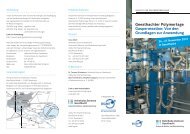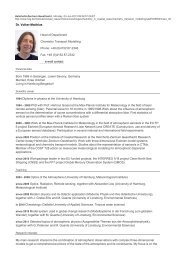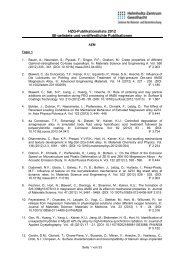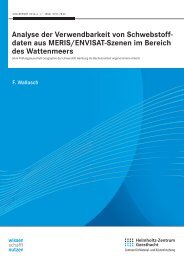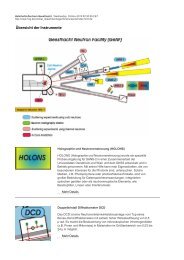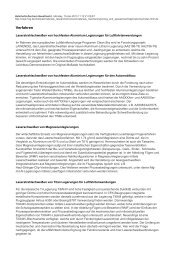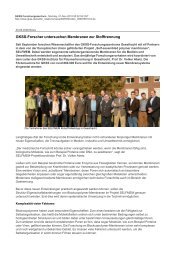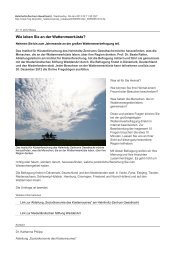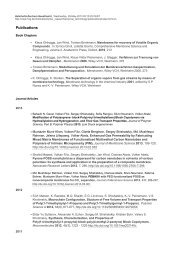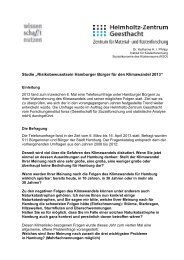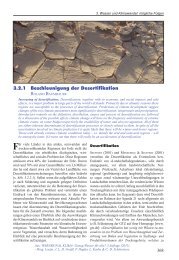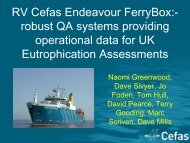High-resolution wave climate analysis in the Helgoland area - GKSS
High-resolution wave climate analysis in the Helgoland area - GKSS
High-resolution wave climate analysis in the Helgoland area - GKSS
You also want an ePaper? Increase the reach of your titles
YUMPU automatically turns print PDFs into web optimized ePapers that Google loves.
2.1 Methods, data and tools 9<br />
2.1.2 HIPOCAS. Short project description.<br />
As has been mentioned <strong>in</strong> Chapter 1, <strong>the</strong> part of this study is, <strong>in</strong> some sense, a logical<br />
extension of <strong>the</strong> HIPOCAS project towards a more detailed near-shore <strong>wave</strong> <strong>climate</strong> description.<br />
Keep<strong>in</strong>g this <strong>in</strong> m<strong>in</strong>d, <strong>the</strong> ma<strong>in</strong> part of <strong>the</strong> external data used for model<strong>in</strong>g <strong>in</strong><br />
this study stems from <strong>the</strong> HIPOCAS results and it seems to be expedient to give a short<br />
overview of <strong>the</strong> project goals, implementation and results <strong>in</strong> this <strong>the</strong>sis. Here <strong>the</strong> motives<br />
and technical details of <strong>the</strong> project are briefly presented toge<strong>the</strong>r with <strong>the</strong> description of<br />
datasets used <strong>in</strong> <strong>the</strong> K-model simulation. The ma<strong>in</strong> results of <strong>the</strong> HIPOCAS validation<br />
and data <strong>analysis</strong> will be described toge<strong>the</strong>r with <strong>the</strong> similar tasks of <strong>the</strong> present study <strong>in</strong><br />
follow<strong>in</strong>g sections. This European project was carried out dur<strong>in</strong>g 2000-2003 and was aimed<br />
at provid<strong>in</strong>g homogeneous and high <strong>resolution</strong> h<strong>in</strong>dcasts of w<strong>in</strong>d, <strong>wave</strong> and storm surge<br />
climatology for European Coastal Areas for <strong>the</strong> period 1958-2002. Detailed description of<br />
<strong>area</strong>s studied with<strong>in</strong> <strong>the</strong> project can be found <strong>in</strong> Soares et al. [2002], fur<strong>the</strong>r description<br />
here is restricted to <strong>the</strong> Sou<strong>the</strong>rn North Sea region.<br />
The quality of numerical <strong>wave</strong> and surge h<strong>in</strong>dcasts is strongly dependent on <strong>the</strong> accuracy<br />
of <strong>the</strong> upper boundary conditions, i.e. driv<strong>in</strong>g w<strong>in</strong>d fields. As has been shown <strong>in</strong> recent<br />
studies, <strong>the</strong> uncerta<strong>in</strong>ty <strong>in</strong> w<strong>in</strong>d fields (Holthuijsen et al. [1996]) or a too coarse time<br />
<strong>resolution</strong> (Brauer and Weisse [2000]) have a considerable impact on <strong>the</strong> predicted <strong>wave</strong><br />
fields. Therefore, obta<strong>in</strong><strong>in</strong>g more homogeneous and detailed w<strong>in</strong>d fields was <strong>the</strong> first goal<br />
of HIPOCAS. This w<strong>in</strong>d h<strong>in</strong>dcast was based on NCEP (National Center for Environmental<br />
Prediction) re<strong>analysis</strong> (Kalnay et al. [1996], R. Kistler and Fioriono [2001]) and subsequent<br />
dynamical downscal<strong>in</strong>g. The regional atmosphere model REMO (REgional MOdel) was set<br />
up for <strong>the</strong> European coastal <strong>area</strong>s as well as for <strong>the</strong> <strong>area</strong>s relevant to <strong>the</strong> generation of swell<br />
which may propagate <strong>in</strong>to selected coastal seas. It was driven on lateral boundaries by <strong>the</strong><br />
NCEP reanalyzed atmospheric fields with 200 km <strong>resolution</strong>. The results were stored every<br />
hour on a spherical grid with a <strong>resolution</strong> of about 50 km (for details see Feser et al. [2001]).<br />
This dataset is referred to later as <strong>the</strong> REMO w<strong>in</strong>d.<br />
The h<strong>in</strong>dcast of <strong>the</strong> sea level evolution and current components was performed by <strong>the</strong><br />
Coastal Division of <strong>the</strong> Federal Eng<strong>in</strong>eer<strong>in</strong>g and Research Institute (BAW) with <strong>the</strong> f<strong>in</strong>ite<br />
element hydrodynamical model TELEMAC2D. The model was driven by <strong>the</strong> REMO w<strong>in</strong>d<br />
and <strong>the</strong> <strong>in</strong>fluence of Atlantic external surges has been taken <strong>in</strong>to account by assimilat<strong>in</strong>g<br />
water elevation measurements at Aberdeen. Results, available on an irregular grid from<br />
few kilometers <strong>in</strong> <strong>the</strong> Nor<strong>the</strong>rn North Sea to hundred meters <strong>in</strong> German Bight, were saved<br />
hourly. For <strong>the</strong> <strong>wave</strong> h<strong>in</strong>dcast <strong>the</strong> WAM-cycle4 <strong>wave</strong> model was set-up with a one-way<br />
nest<strong>in</strong>g technique. The coarse grid with spatial <strong>resolution</strong> of 0.75 ◦ lon. x 0.5 ◦ lat covered<br />
<strong>the</strong> entire North Sea and part of Nor<strong>the</strong>ast Atlantic. For this simulation <strong>the</strong> WAM deepwater<br />
version was governed by <strong>the</strong> REMO w<strong>in</strong>d. The model output was stored every 3<br />
hours and later referred as <strong>the</strong> HC (Hipocas Coarse) run. The nested f<strong>in</strong>e grid covers<br />
<strong>the</strong> Sou<strong>the</strong>rn North Sea between 51 ◦ N and 56 ◦ N, and between −3 ◦ W and 10.5 ◦ E with a<br />
<strong>resolution</strong> of about 5 x 5 km. It was driven by hourly REMO w<strong>in</strong>d fields and HC <strong>wave</strong><br />
spectra on <strong>the</strong> boundaries. In addition, for this run, <strong>the</strong> shallow water effects have been<br />
taken <strong>in</strong>to account by us<strong>in</strong>g <strong>the</strong> shallow-water version of <strong>the</strong> WAM model. Model results



